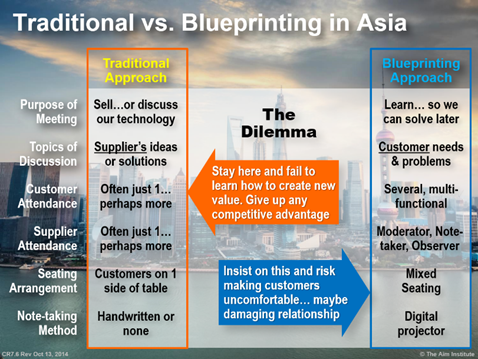How to persuade your sales colleagues to set up Discovery interviews in Asia.
If you ask your Asian sales professionals to set up “proper” Discovery interviews—and they have not received some level of Blueprinting training—it’s unlikely you’ll have good results. What you’ll probably hear from them is, “the customer doesn’t want us to use a projector.”
This is only natural: Your sales professional doesn’t want to embarrass themselves or their customers with an approach that seems odd and “foreign.” The best antidote is to get your sales colleagues up to speed with one of these approaches:
- Invite them to view “Blueprinting for Sales”… a BlueTool they can access by going to www.blueprintingforsales.com. Be sure to set up a time to have a phone call with them to see if they have any questions you can answer.
- While the above is a good start, we strongly recommend you conduct a practice interview with your sales colleague. Let them be the “customer” so they can experience this first hand… either in a face-to-face situation or via web-conference. Tip: During this interview, make your sticky notes “accidentally” disappear and keep the interview going for a few minutes. Then ask which they preferred… being able to see the sticky notes or not. Point out that their customers will likely feel the same way.
- Arrange more complete training for your sales colleagues. You may want to invite them to a full 2-day Blueprinting workshop… or a special “sales-only” version of the this that can be held in a single day (and involves a good deal of hands-on interviewing role-playing.)
- Ask your sales colleagues to start by asking their friendlier, smaller accounts for a Discovery interview. They can say this is something new they want to try out.
- Finally, its OK if the first few interviews have some “traditional” components to them and your team graduates to more complete Blueprinting interviews over several interviews. This illustration shows the more traditional way of interacting with customers on the left… and the Blueprinting approach on the right.

On the last point: If your business continues with the traditional approach, it loses the competitive advantage of learning more about customer needs than competitors. If you push too hard, too fast to a complete Blueprinting approach, you could make sales colleagues and customers uncomfortable.
In our experience, the most important Blueprinting elements to eventually get to are a) focusing on customer needs, and b) using a digital projector to engage fully engage them.
Keywords: culture, cultural difference, global cultures, interviews in Asia, Asian sales colleagues, Asian sale professionals
